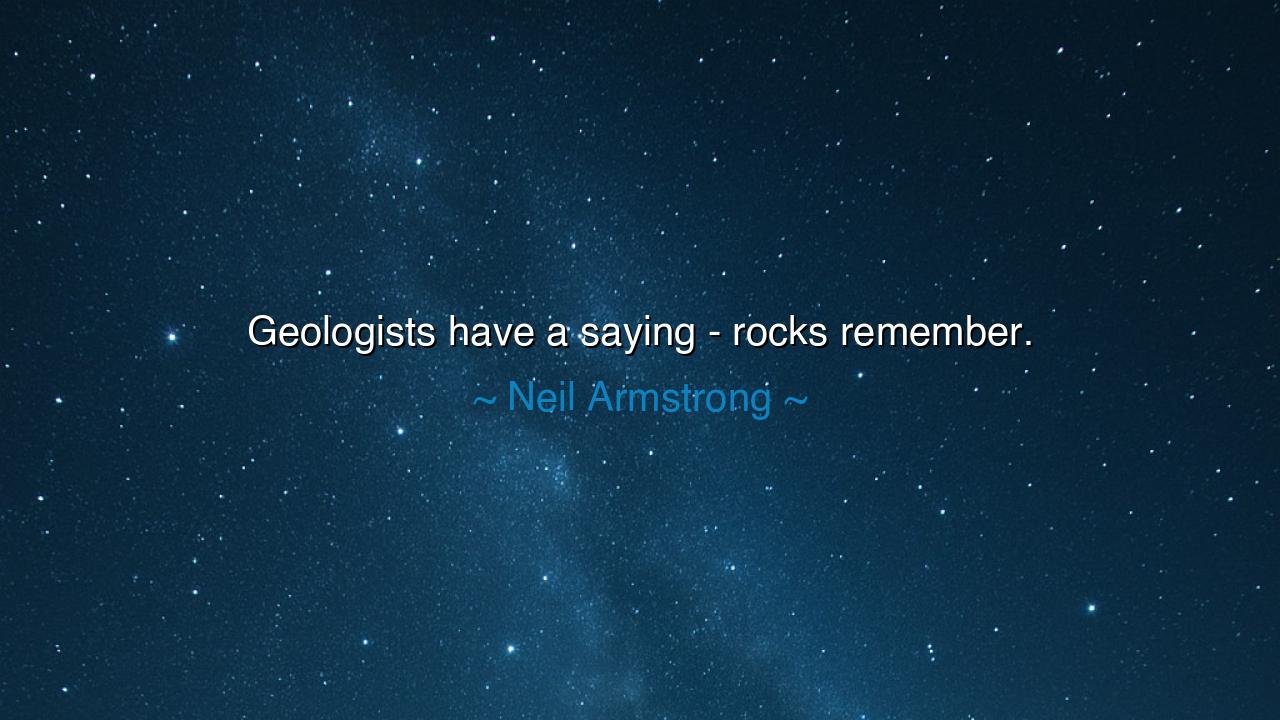
Geologists have a saying - rocks remember.






Neil Armstrong, who first set foot upon the Moon and carried the gaze of all humanity with him, once spoke these words: “Geologists have a saying—rocks remember.” At first, the phrase may sound simple, even quaint. But within it lies a truth as deep as the earth itself: that stone, silent and unmoving, bears witness to the ages. Where men forget, where empires crumble, where words fade, the rocks endure. They carry within their layers the memory of fire and flood, of birth and destruction, of all that has shaped the world since its dawn.
The ancients too knew this wisdom, though they spoke of it in myth. Mountains were to them the bones of the earth, eternal guardians that watched the rise and fall of kings. Stones were seen as sacred, holding the whispers of the gods and the weight of history. Armstrong’s words echo this ancient reverence: rocks remember what men cannot, for their patience is greater than ours, and their memory carved by forces beyond our lifetimes.
Consider the tale of the Grand Canyon, where walls of stone rise like temples, each layer a page in the earth’s book. To the unknowing eye, it is merely a chasm; but to the geologist, it is a chronicle of nearly two billion years. The strata tell of vanished seas, of shifting continents, of climates long forgotten. The rocks speak—if only we learn to listen. They remember not in words, but in form, in fossil, in mineral, in fracture. And in their memory, they offer us a vision of the earth not as it seems today, but as it has always been becoming.
Armstrong himself knew this truth in a way few men ever have. When he bent to gather moon rocks in the Sea of Tranquility, he was not collecting souvenirs, but fragments of cosmic memory. Those silent stones, untouched for billions of years, carried within them the record of the Moon’s fiery birth, its bombardments, its long solitude. By bringing them to Earth, Armstrong carried not just rock, but the memory of another world—a story written in silence, waiting for human minds to decipher.
And yet, the saying also holds a lesson for our lives. For are we not, in a sense, like the rocks? Our hearts, too, remember—the joys and sorrows, the trials and triumphs that shape us. Time may bury them, just as soil buries stone, but they remain, etched deep within. To pretend otherwise is folly; to ignore them is blindness. But to honor these memories, to learn from them, is wisdom. Just as geologists read the language of the rocks, so too must we learn to read the stories written in our own lives.
But beware: memory can be both burden and blessing. The rocks remember catastrophe as well as creation—earthquakes, volcanoes, extinctions. Yet even from these came renewal, new life, new form. So it is with us: our hardest trials may remain etched in us forever, but they need not bind us in despair. They can serve as foundations, as lessons, as strength upon which to build a new world.
Therefore, children of the future, hear this teaching: listen to the rocks. Listen to the patience of stone, to the memory of the earth, to the silent witness of creation itself. Do not be swift to forget, but neither be enslaved by memory. Instead, let remembrance become wisdom, guiding your steps as surely as the geologist reads the strata to find truth. For the rocks remember—and if we, too, can learn to remember rightly, we shall stand as steadfast as mountains, enduring through the ages.






AAdministratorAdministrator
Welcome, honored guests. Please leave a comment, we will respond soon